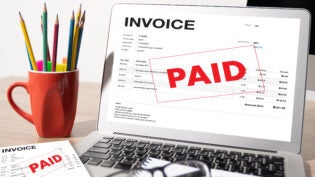
Cash flow problems can cripple a small business. In fact, this is the No. 1 reason startups fail, according to CB Insights. There are lots of reasons why a small business may run into a cash-flow crunch, including:
- Launching prematurely: Starting your business before you have sufficient capital
- High debt load: When a large chunk of your business income is going toward debt payments
- High accounts receivable: When outstanding invoices create a slowdown in capital
- Low sales: This can be seasonal or a more persistent downward trend
- Your business budget isn’t working: When your budget isn’t built to accommodate your actual income and expenses
Keeping up with regular business expenses — and growing your operations — can be tough if there’s a stall in working capital. The good news is that cash-strapped business owners can take steps to avoid cash flow woes. Here’s how.
1. Create a cash flow analysis
The first step to solving cash flow issues is to identify where the problem is coming from. This is where a cash flow analysis can be especially valuable. When done right, it can clarify exactly how much money is moving in and out of your business. Just like with a personal budget, the goal is to understand if your operation is bringing in enough money to cover all of its financial obligations. Leftover funds can then be reinvested into the business.
You’ll need your business’s cash flow statement to get started, which should include your income and expenses on either a monthly or annual basis. From there, you’ll want to:
- Pinpoint all sources of income
- Clarify all business expenses
- Create a cash flow statement that includes operating expenses, company investments and any financing arrangements that are in place
After crunching the numbers, your next task is to look for patterns and find ways to free up cash. The ultimate goal is for your regular operating activities to generate positive cash flow.
2. Track income payments
Some businesses have cash tied up in outstanding invoices. In this case, you might consider investing in, or updating, your business’s accounting software. The right platform can:
- Track your expenses
- Record financial transactions
- Automatically send invoices
- Generate financial reports
- Handle your business’s payroll needs
When you’re automating your invoices and have a system to easily accept payments, your outstanding invoices might get paid faster. Another option is accounts receivable financing. It allows you to receive funding in the form of a loan or line of credit, with your unpaid invoices used as collateral.
3. Streamline your payment options
One of the perks of accounting software is that it makes it easier to bill your customers. Invoices are generated and sent out automatically, taking one more task off your shoulders — and hopefully decreasing payment times. Being successful here has everything to do with your accepted payment options. If you’re relying on check payments, that could create a real lag in cash flow.
Online payments are a modern approach that can shorten the time it takes for your business to get paid. Here are some simple ways to do this, according to payment management platform PaySimple:
- Accept online debit and credit card payments
- Allow for eCheck and ACH payments
- Consider mobile payments
- Create an online payment form
- Explore email invoices with a click-to-pay option
- Allow customers to set up recurring bill payments
4. Look for new vendors
When reviewing your cash flow analysis, you may find some steep business expenses hiding in plain sight. Looking for new vendors might help you find better deals — and unlock some cash in your budget. Zero in on your business’s regular operating costs. That can include everything from rent for an office or retail space to utility bills. You’ll also want to look at any vendors that provide necessary services for your business. If you run a restaurant, for example, that might be a company that provides food service supplies. For online businesses, it could be an internet service provider.
Once you’re clear on your vendors and how much they’re charging you, consider shopping around for better prices. The simple act of gathering quotes from competitors might help you negotiate lower rates with your existing vendors.
5. Build up your business’s cash reserves
Everyone needs an emergency fund, including businesses. The truth is that unexpected stuff happens when you’re running a small business. Having cash reserves on hand can enable you to respond quickly so you can get back to work.
Whether you’re faced with a major issue or a temporary slowdown in sales, cash savings can be your safety net. One rule of thumb is to save up three to six months’ worth of business expenses, according to The PNC Financial Services Group. Keeping this money in a high-yield savings account can help those funds work a little harder for you.
6. Take stock of your inventory
Your unused inventory could be a source of quick cash. Take a closer look at what you’ve got in stock. You can also review sales trends from the last few months. What’s selling? What isn’t? A surplus of inventory probably isn’t doing your business much good. Now may be the time to mark down prices and run sales to offload excess items. Selling those items for less than you planned is probably better than not selling them at all. Connect with your marketing team to come up with creative sales events and other clever ways to market extra inventory.
You can also rethink your approach to buying inventory. If you consistently have more goods than you’re able to sell, you might choose to scale back and purchase fewer items going forward.
7. Reevaluate your debt situation
Small business financing comes in lots of shapes and sizes. That includes:
- Credit cards
- Loans
- Lines of credit
- Equipment financing
- Invoice financing
Take a minute to tally up how much you’re spending each month on debt payments. It could be taking a big bite out of your cash flow, especially if you’re on the hook for high interest rates. One potential solution is to consolidate and refinance your business debt. This involves taking out a new loan and using that to absorb your outstanding balances. From there, you’ll have one monthly payment and interest rate.
Another option is to seek funding from outside investors. If you aren’t keen on giving up equity, you can also consider applying for small business grants. These funds are provided by the government or private groups, and they don’t need to be repaid. Grants.gov is a good place to start looking for opportunities.
8. Consider working with a tax professional
From a tax perspective, running a small business can be confusing. You’ll need to follow complex financial rules and regulations. A tax professional can help you do this — and they can also help you find tax deductions you didn’t know you qualified for. That could, in turn, reduce your tax liability and free up some much-needed cash. What’s more, the right tax professional can help your business plan for the future in the most tax-efficient way possible.
Small business owners have plenty on their plates. For many, cash flow issues represent a real hurdle. Knowing how to overcome them can help your business get over the hump and ultimately thrive.
1459 Views











